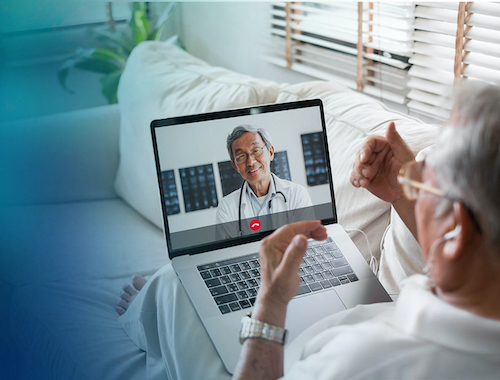APRIL 3, 2017
You probably don’t give your gallbladder much thought. It’s one of those organs in the body that just quietly does its job and we never have to think about it – until something goes wrong.
The gallbladder is a pear-shaped organ that sits just below the liver on the right side of the abdomen. The gallbladder and the bile ducts comprise the biliary tract, a part of the body’s digestive system. The liver produces bile, a substance that serves to carry waste products and toxins out of the body. Bile also assists the body in digesting fat and certain vitamins, including A, D, E, and K.
The purpose of the gallbladder is to store the bile and then release it when we eat. The gallbladder releases bile through the bile ducts, which then mixes with food in the first section of the small intestine.
“While the gallbladder serves a purpose, it is not an essential organ,” says general surgeon Dr. John Birbari. “If the gallbladder is causing problems, such as gallstones that cause pain, the best solution is usually to simply remove the gallbladder.”
What are Gallstones?
An imbalance in the substances that comprise bile – such as too much cholesterol or an inadequate level of bile salts – can result in gallstones, which form in the gallbladder and can block the bile ducts. Gallstones are hard particles that can vary greatly in size – some are as small as a grain of sand while others can be as large as a golf ball. It is possible to just have one gallstone or many of varying sizes, at the same time.
Sometimes gallstones cause no noticeable symptoms. However, when a gallstone blocks the bile ducts, a “gallbladder attack” results, causing a sharp and sudden pain in the abdomen.
Gallstone Risk Factors
Some people are more likely than others to develop gallstones:
- Gender: women are more likely than men to develop gallstones, as estrogen can cause an increase in cholesterol in the bile.
- Age: people over the age of 40 are at greater risk than younger people.
- Heredity: people with a family history are at greater risk.
- Ethnicity: American Indians and Mexican Americans have a greater risk.
In addition, there are several risk factors for gallstones, including:
- Obesity, which can cause an increase in cholesterol in the bile.
- Rapid weight loss can cause the gallbladder to inadequately empty bile and may also cause the liver to secrete extra cholesterol. Extreme dieting or fasting, as well as weight-loss surgeries, can pose an increased risk of gallstones.
- A diet that is high in calories and refined carbohydrates and low in fiber raise the risk of gallstones. White flour and white rice are examples of refined carbohydrates.
- Certain medical conditions, such as diabetes, Crohn’s Disease, and Metabolic Syndrome all add to gallstone risk.
“As is the case with many medical conditions, lifestyle choices play an important role in whether we develop gallstones,” says Dr. Garish Alexander, a general surgeon. “Managing weight with balanced diet and exercise, as well as properly managing chronic conditions, helps to reduce the risk of gallbladder problems.”
Gallstone Symptoms
Many people have gallstones present which cause no problems at all. These “silent” gallstones do not interfere with the functioning of the digestive system. Symptoms occur when gallstones block the bile ducts, leading to an increase in pressure in the gallbladder and a sudden onset of pain.
These gallbladder attacks usually last for a few hours or less. The pain subsides when the gallstones move and no longer block the bile ducts, allowing the gallbladder to release bile. However, if the pain persists, this means the gallstones are not dislodging from the bile ducts – a serious situation, as prolonged blockage can lead to inflammation and infection of the gallbladder, the liver, bile ducts or pancreas.
Anyone experiencing abdominal pain for more than five hours should seek emergency medical care. Other symptoms accompanying a gallbladder attack that require immediate medical attention include fever and chills, nausea and vomiting, yellowing of the skin and whites of the eyes (jaundice) and tea-colored urine or light-colored stools.
Gallstone Diagnosis
While gallbladder attacks usually subside within a few hours, they are likely to reoccur, especially after eating a heavy meal. Anyone who has experienced the symptoms of a gallbladder attack should make an appointment to see their physician for evaluation.
If your physician suspects gallstones, he or she will likely order an imaging test to check. An ultrasound is the most common diagnostic test used for gallstone detection, but an MRI or CT scan may also be used in some cases.
A physician may also order a blood test to check for signs of infection in the gallbladder, bile ducts, pancreas or liver.
If gallstones are present in someone who has experienced gallbladder attacks, the usual treatment is removal of the gallbladder, as we can function normally without this organ. In cases where a person is not able to undergo surgery, procedures to dissolve gallstones may be used. However, the gallstones are likely to reoccur.
In some cases, a physician may detect silent gallstones while examining a patient for another reason. “If we find gallstones that are not yet causing problems, we will likely recommend the patient increase exercise levels and eat more fruits and vegetables and less carbohydrate-heavy foods. Taking these steps can help to reduce the risk of developing additional gallstones and suffering gallbladder attacks,” says Dr. Travis Crudup, a general surgeon.
Gallbladder Surgery
Gallbladder removal surgery – a cholecystectomy – is one of the more common surgeries performed in the United States.
Cholecystectomies are most commonly done laparoscopically – in this procedure, the surgeon makes several small incisions in the abdomen, allowing insertion of a camera and small surgical tools. The gallbladder is removed and the incisions are sealed. Most laparoscopic gallbladder surgeries are outpatient, meaning they do not require an overnight hospital stay.
In the event laparoscopic surgery is not feasible, an open cholecystectomy is performed. In this procedure, the surgeon makes an incision of about six inches and then removes the gallbladder. An open cholecystectomy generally requires the patient to remain in the hospital for a few days.
After the gallbladder is removed, the bile flows directly from the liver into the bile ducts and then into the small intestine.
Most people are able to return to work a few days after gallbladder surgery. Your surgeon will provide specific instructions on when you can resume normal activities.
Conclusion
“Hopefully your gallbladder never causes you any problems,” says Dr. Fernando Garcia, a general surgeon. “But if you’re experiencing pain in your abdomen that recurs on a regular basis, you need to get checked out to determine the cause. If it’s because you have gallstones, know that this is a fairly common condition that can often be fully resolved with an outpatient, minimally invasive surgery.”
This article contains information sourced from:
The National Institute of Diabetes and Digestive and Kidney Diseases, National Institutes of Health





